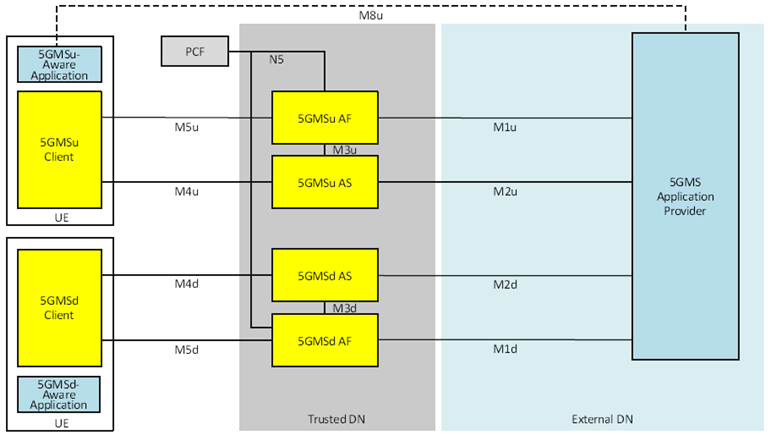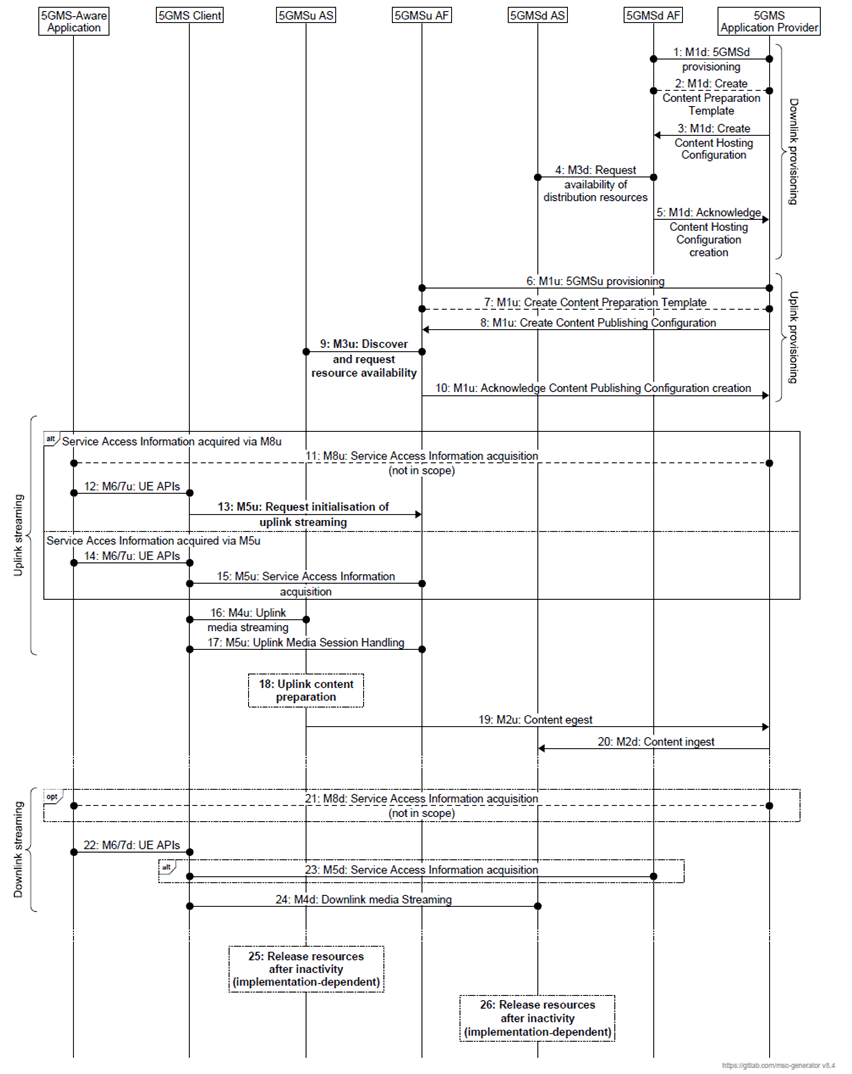Content for TS 26.501 Word version: 18.6.0
1…
4…
4.0.6…
4.1…
4.2…
4.2.2…
4.3…
4.4
4.5…
4.6…
4.7…
4.7.4…
4.8
4.9…
4.10…
5…
5.2…
5.2.4
5.2.5…
5.3…
5.3.2…
5.4…
5.5…
5.6…
5.7…
5.7.4…
5.7.8
5.8…
5.10…
5.10.5…
5.10.6…
5.11…
5.12…
5.12.4…
5.12.5…
6…
6.2…
6.2.2.2…
6.2.3…
6.3…
6.4…
6.8…
6.9…
6.9.5…
6.9.7
7…
8…
9…
A…
A.4…
A.8
A.9
A.10
A.11
A.12
A.13
A.14
A.15…
A.15.3…
B…
B.3
C…
C.3
C.4
C.5
D…
E…
A.15 Cascaded uplink and downlink media streaming using content preparation
A.15.1 Introduction
A.15.2 Cascaded uplink and downlink media streaming using content preparation with external content re-ingestion
...
...
A.15 Cascaded uplink and downlink media streaming using content preparation |R18| p. 211
A.15.1 Introduction p. 211
This scenario represents a hybrid end-to-end form of collaboration across uplink media streaming and downlink media streaming services. An external 5GMS Application Provider relies on the 5GMS System to support both the uplink streaming media transmission by 5GMSu Clients and subsequent redistribution of that content via downlink media streaming for reception by 5GMSd Clients within the same 5GMS System.
Two distinct methods are described in the following clauses.
- In the first method (clause A.15.2) the content contributed to the 5GMSu AS using uplink media streaming is transferred indirectly to the 5GMSd AS via a 5GMS Application Provider for redistribution using downlink media streaming.
- In the second method (clause A.15.3) the content contributed to the 5GMSu AS using uplink media streaming is transferred directly from the 5GMSu AS to the 5GMSd AS without any intermediary.
A.15.2 Cascaded uplink and downlink media streaming using content preparation with external content re-ingestion p. 211
In a first variant of this collaboration scenario, content contributed to the 5GMS System by the 5GMSu Client is egested by the 5GMSu AS at reference point M2u (by either push- or pull-based means) and subsequently ingested by the 5GMSd AS from the 5GMS Application Provider at reference point M2d (by either push- or pull-based means).

Figure A.15.2-1: Cascaded uplink and downlink media streaming with external content re-ingestion
(⇒ copy of original 3GPP image)
(⇒ copy of original 3GPP image)
Figure A.15.2-2 shows the call flow for this scenario. (To simplify the call flow, the details of the content preparation process are omitted.)

Figure A.15.2-2: Call flow for cascaded uplink and downlink media streaming using content preparation with external content re-ingestion
(⇒ copy of original 3GPP image)
(⇒ copy of original 3GPP image)
Steps:
Step 1.
At some later point in time:
The 5GMSd Application Provider creates a Provisioning Session with the 5GMSd AF (M1d).
Step 2.
The 5GMS Application Provider may provision the 5GMSd AF with a Content Preparation Template (M1d).
Step 3.
The 5GMSd Application Provider provisions the 5GMSd AF with a Content Hosting Configuration. The ingest configuration indicates that content will be ingested from the 5GMS Application Provider by either pull- or push-based means. If a Content Preparation Template was provisioned in the previous step, the Content Hosting Configuration may reference it.
Step 4.
The 5GMSd AF, based on the provisioned Content Hosting Configuration and Content Preparation Template, requests the 5GMSd AS to confirm the availability of content distribution resources (M3d).
Step 5.
The 5GMSd AF acknowledges to the 5GMSd Application Provider the successful creation of the Content Hosting Configuration (M1d).
Step 6.
The 5GMS Application Provider creates a Provisioning Session with the 5GMSu AF (M1u).
Step 7.
The 5GMS Application Provider may provision the 5GMSu AF with a Content Preparation Template (M1u).
Step 8.
The 5GMS Application Provider provisions the 5GMSu AF with a Content Publishing Configuration (M1u). The egest configuration indicates that contributed content will be made available to the 5GMS Application Provider by either pull- or push-based means. If a Content Preparation Template was provisioned in the previous step, the Content Publishing Configuration may reference it.
Step 9.
The 5GMSu AF, based on the provisioned Content Hosting Configuration and Content Preparation Template (if any) requests the 5GMSu AS to confirm the availability of content contribution resources (M3u).
Step 10.
The 5GMSu AF acknowledges successful provisioning to the 5GMSu Application Provider (M1u).
Step 11.
Alternatively:
The 5GMSu Application Provider provides Service Access Information for uplink media streaming to the 5GMSu-Aware Application at reference point M8u.
Step 12.
The 5GMSu-Aware Application requests the 5GMSu Client to start an uplink streaming session (M6u/M7u).
Step 13.
The 5GMSu Client requests that the 5GMSu AF initialises uplink media streaming (M5u).
Step 14.
At some later point in time:
The 5GMSu-Aware Application requests the 5GMSu Client to start an uplink streaming session (M6u/M7u).
Step 15.
The 5GMSu Client requests Service Access Information from the 5GSMu AF at reference point M5u.
Step 16.
Steps 21-24 concern the 5GMS downlink streaming process:
Uplink media streaming starts from the 5GMSu Client to the 5GMSu AS (M4u).
Step 17.
The 5GMSu Client invokes media session handling procedures during the uplink media streaming session (M5).
Step 18.
If content preparation was provisioned in step 7, the uplinked media may be manipulated by the 5GMSu AS prior to being egested by it.
Step 19.
The 5GMSu AS egests the content to the 5GMS Application Provider (M2u) by pull- or push-based means according to the Content Publishing Configuration provisioned in step 8.
Step 20.
The 5GMSd AS ingests the content from the 5GMS Application Provider (M2d) by pull- or push-based means according to the Content Hosting Configuration provisioned in step 3.
Step 21.
Finally:
The 5GMS Application Provider optionally provides Service Access Information for downlink media streaming to the 5GMSd-Aware Application (M8d).
Step 22.
The 5GMSd-Aware Application requests the 5GMSd Client to start an uplink streaming session (M6d/M7d).
Step 23.
If Service Access Information was not provided in step 21, the 5GMSd Client requests this information from the 5GSMd AF (M5d).
Step 24.
Downlink media streaming starts from the 5GMSd AS to the 5GMSd Client (M4d).